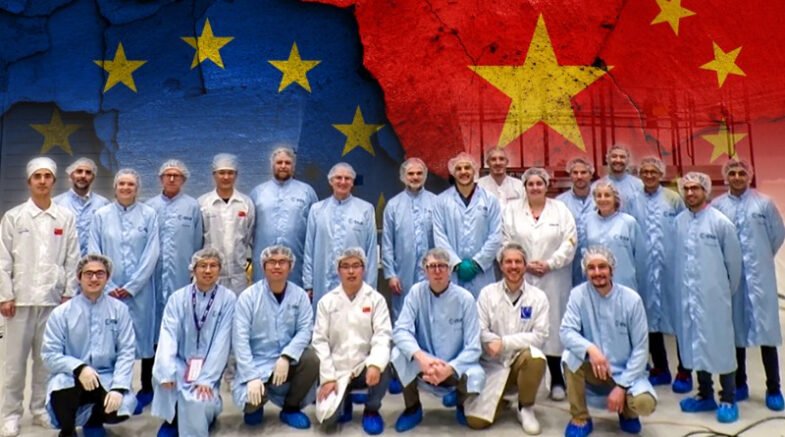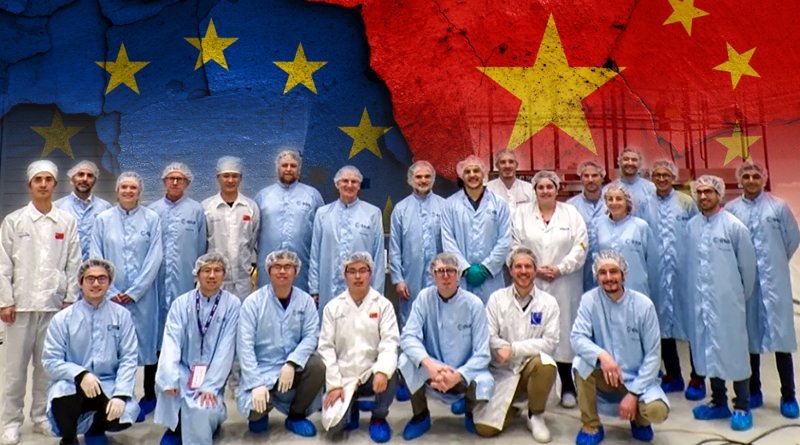This month, a Chinese team travelled to Noordwijk in the Netherlands to work with colleagues at the European Space Research and Technology Centre under the ESA.

Scientists from China (CN) and Europe (EU) worked together in an unprecedented way to complete prototype satellite key tests for a joint space mission that will be launched on a European rocket in 2025.
The solar wind magnetosphere ionosphere link explorer, or SMILE, has been designed and developed jointly by the Chinese Academy of Sciences (CAS) and the European Space Agency (ESA) since 2015 to create the most powerful tool for studying the Earth’s magnetic environment.
This month, a Chinese team travelled to Noordwijk in the Netherlands to work with colleagues at the European Space Research and Technology Centre under the ESA.
They tested whether a prototype satellite of the mission – whose parts, including one from Europe, were assembled at the Innovation Academy for Microsatellites in Shanghai and shipped to Europe – could dock with and separate from the European launcher as designed.
These satellite prototype tests were deemed successful, and “excellent collaboration was established” between the Chinese and European teams and the rocket company Arianespace, according to Italian astronomer Graziella Branduardi-Raymont, the mission’s co-principal investigator from University College London.
It marked the first time a satellite made in China was shipped to the ESA, and for a Chinese team to help assemble and test a satellite at an ESA facility.
A weekly curated round-up of social, political and economic stories from China and how they impact the world. SMILE offers a novel approach to monitoring the Earth’s magnetic environment globally via a process known as “solar wind charge exchange”.
In the early 2000s, Branduardi-Raymont and her team proposed to the ESA a couple of candidate missions to use such an idea to study the impact of the solar wind, but their proposals were not chosen. Wang Chi in Beijing proposed an ESA-CAS joint mission in 2015.
From a highly elliptical polar orbit, SMILE will use four cutting-edge instruments to continuously capture images of the interaction between the solar wind and the Earth’s magnetosphere in the X-ray and ultraviolet wavebands.
One of those instruments was developed by the University of Leicester with £3 million (US$3.6 million) in funding from the UK Space Agency. The other three were built in China.
Besides the scientific instruments, the ESA and China also share building the satellite system, conducting science operations and other aspects of the project. The mission marks the first time that the ESA and China have jointly selected, designed, implemented, launched and operated a space mission together, according to the ESA.
SMILE is a new role model for China-Europe collaboration in space science following the successful Double Star mission between the ESA and the China National Space Administration in the 1990s.
“Our collaboration with the Chinese side has been and is very successful, with good exchange of information and flexibility to adapt and resolve any issues that may arise,” Branduardi-Raymont said.
Originally expected to launch in 2021, SMILE had setbacks because of the Covid-19 pandemic and geopolitical tensions.
The outbreak of the pandemic made planned trips to Europe and the launching site impossible. When devices from the ESA arrived in Shanghai in March 2022, the city was under a massive lockdown and the entire team had to live at the institute for weeks to get the work done, said a researcher from the Innovation Academy for Microsatellites.
At first, a Canadian team offered to develop one of the four instruments. “However, their funding would come from the Canadian Space Agency, which decided to pull out of the project after the design had been finalised,” the researcher told the Post during the national space science conference in Taiyuan in August.
Meanwhile, a Norwegian research station in Antarctica could no longer provide tracking services while SMILE makes orbital transfers over the South Pole, said the researcher, who asked to remain anonymous because she was not authorised to speak to the media.
Reuters reported this month that in 2020, Sweden’s state-owned space company, which had provided ground stations that helped fly Chinese spacecraft and transmit data, declined to renew contracts with China or accept new Chinese business because of “changes” in geopolitics.
SMILE is expected to launch atop Arianespace’s Vega-C rocket from Europe’s spaceport in Kourou, South America, around April 2025. Branduardi-Raymont said there was still a lot of work to be done before the launch, from instrument development to integration and testing – this time for the satellite to go into orbit.
